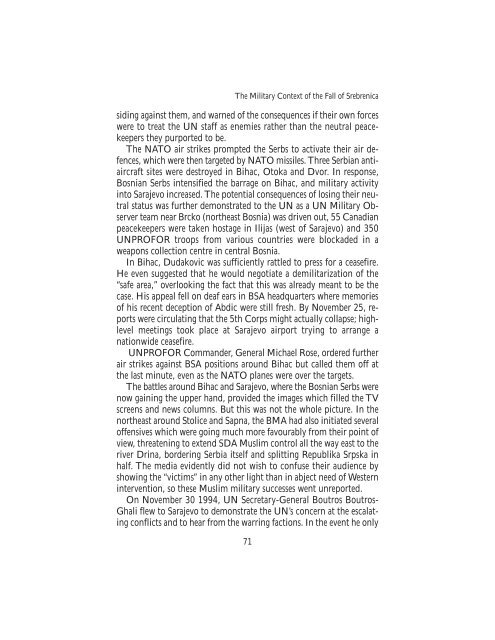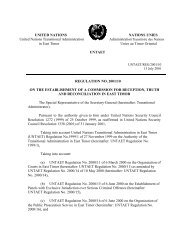The Srebrenica Massacre - Nova Srpska Politicka Misao
The Srebrenica Massacre - Nova Srpska Politicka Misao
The Srebrenica Massacre - Nova Srpska Politicka Misao
You also want an ePaper? Increase the reach of your titles
YUMPU automatically turns print PDFs into web optimized ePapers that Google loves.
<strong>The</strong> Military Context of the Fall of <strong>Srebrenica</strong><br />
siding against them, and warned of the consequences if their own forces<br />
were to treat the UN staff as enemies rather than the neutral peacekeepers<br />
they purported to be.<br />
<strong>The</strong> NATO air strikes prompted the Serbs to activate their air defences,<br />
which were then targeted by NATO missiles. Three Serbian antiaircraft<br />
sites were destroyed in Bihac, Otoka and Dvor. In response,<br />
Bosnian Serbs intensified the barrage on Bihac, and military activity<br />
into Sarajevo increased. <strong>The</strong> potential consequences of losing their neutral<br />
status was further demonstrated to the UN as a UN Military Observer<br />
team near Brcko (northeast Bosnia) was driven out, 55 Canadian<br />
peacekeepers were taken hostage in Ilijas (west of Sarajevo) and 350<br />
UNPROFOR troops from various countries were blockaded in a<br />
weapons collection centre in central Bosnia.<br />
In Bihac, Dudakovic was sufficiently rattled to press for a ceasefire.<br />
He even suggested that he would negotiate a demilitarization of the<br />
“safe area,” overlooking the fact that this was already meant to be the<br />
case. His appeal fell on deaf ears in BSA headquarters where memories<br />
of his recent deception of Abdic were still fresh. By November 25, reports<br />
were circulating that the 5th Corps might actually collapse; highlevel<br />
meetings took place at Sarajevo airport trying to arrange a<br />
nationwide ceasefire.<br />
UNPROFOR Commander, General Michael Rose, ordered further<br />
air strikes against BSA positions around Bihac but called them off at<br />
the last minute, even as the NATO planes were over the targets.<br />
<strong>The</strong> battles around Bihac and Sarajevo, where the Bosnian Serbs were<br />
now gaining the upper hand, provided the images which filled the TV<br />
screens and news columns. But this was not the whole picture. In the<br />
northeast around Stolice and Sapna, the BMA had also initiated several<br />
offensives which were going much more favourably from their point of<br />
view, threatening to extend SDA Muslim control all the way east to the<br />
river Drina, bordering Serbia itself and splitting Republika <strong>Srpska</strong> in<br />
half. <strong>The</strong> media evidently did not wish to confuse their audience by<br />
showing the “victims” in any other light than in abject need of Western<br />
intervention, so these Muslim military successes went unreported.<br />
On November 30 1994, UN Secretary-General Boutros Boutros-<br />
Ghali flew to Sarajevo to demonstrate the UN’s concern at the escalating<br />
conflicts and to hear from the warring factions. In the event he only<br />
71



